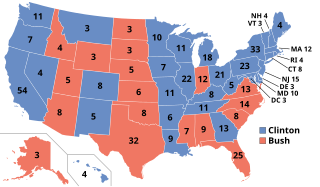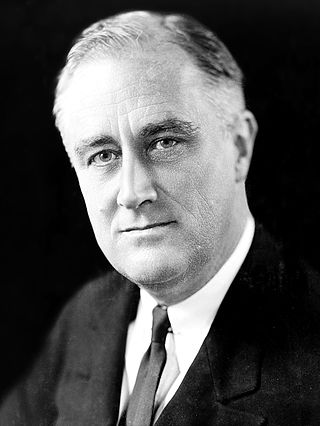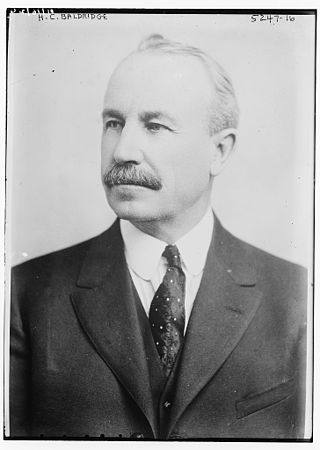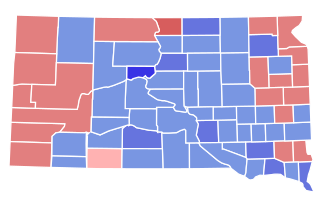
The 1992 United States presidential election was the 52nd quadrennial presidential election, held on Tuesday, November 3, 1992. Democratic Governor Bill Clinton of Arkansas defeated incumbent Republican President George H. W. Bush and independent businessman Ross Perot of Texas. The election marked the end of a period of Republican dominance in American presidential politics that began in 1968, and also marked the end of 12 years of Republican rule of the White House, as well as the end of the Greatest Generation's 32-year American rule and the beginning of the baby boomers' 28-year dominance until 2020. It was the last time the incumbent president failed to win a second term until Donald Trump in 2020.

The 1932 United States presidential election was the 37th quadrennial presidential election, held on Tuesday, November 8, 1932. The election took place against the backdrop of the Great Depression. The incumbent Republican President Herbert Hoover was defeated in a landslide by Democrat Franklin D. Roosevelt, the governor of New York and the vice presidential nominee of the 1920 presidential election. Roosevelt was the first Democrat in 80 years to simultaneously win an outright majority of the electoral college and popular vote, a feat last accomplished by Franklin Pierce in 1852, as well as the first Democrat in 56 years to win a majority of the popular vote, which was last done by Samuel J. Tilden in 1876. Roosevelt was the last sitting governor to be elected president until Bill Clinton in 1992. Hoover became the first incumbent president to lose an election to another term since William Howard Taft in 1912, and the last to do so until Gerald Ford lost 44 years later. The election marked the effective end of the Fourth Party System, which had been dominated by Republicans. It was the first time since 1916 that a Democrat was elected president.

Charles Benjamin Ross was an American politician who served as the first Idaho-born governor from 1931 to 1937.

John William Thomas was an American politician, a United States Senator from Idaho. A Republican, he served for a total of over ten years in two different seats, both times appointed after his predecessor died in office. He won three of the four elections for senator, falling only in the Democratic landslide of 1932, and died in office.

Henry Clarence Baldridge was an American politician. A Republican, he was the 14th governor of Idaho, serving from 1927 until 1931.
The 1928 Democratic National Convention was held at Sam Houston Hall in Houston, Texas, June 26–28, 1928. The keynote speaker was Claude G. Bowers. The convention resulted in the nomination of Governor Alfred E. Smith of New York for president and Senator Joseph T. Robinson of Arkansas for vice president.

The 1992 United States elections elected state governors, the President of the United States, and members of the 103rd United States Congress. The election took place after the Soviet Union crumbled and the Cold War ended, as well as the redistricting that resulted from the 1990 census. Often considered "The Year Of The Woman," these elections brought an increased number of female politicians to Washington such as Dianne Feinstein (D-CA) and Carol Moseley Braun (D-IL). Governor Bill Clinton of Arkansas defeated incumbent President George H. W. Bush and businessman Ross Perot in the presidential election. The Democratic Party maintained their control of both chambers of Congress. This is the first Democratic trifecta since the Republican victory in the 1980 elections and the last one during the 20th century and the last one overall until 2008.

The 1992 United States presidential election in Massachusetts took place on November 3, 1992, as part of the 1992 United States presidential election. Voters chose 12 representatives, or electors to the Electoral College, who voted for president and vice president.

The 1996 United States presidential election in Massachusetts took place on November 5, 1996, as part of the 1996 United States presidential election. Voters chose 12 representatives, or electors to the Electoral College, who voted for president and vice president.

The 1936 United States presidential election in Kansas took place on November 3, 1936 as part of 1936 United States presidential election held in all forty-eight contemporary states. Kansas voters chose nine electors, or representatives to the Electoral College, who voted for President and Vice President.

The 1928 Massachusetts gubernatorial election was held on November 6, 1928.

The 1938 Idaho gubernatorial election was held on November 8. Incumbent Democratic governor Barzilla Clark ran for re-election, but was defeated in the August primary by former three-term governor C. Ben Ross. The general election was won by Republican nominee C. A. Bottolfsen, who received 57.30% of the vote.

The 1936 Idaho gubernatorial election was held on November 3. Vying for an open seat, Democratic nominee Barzilla Clark defeated Republican nominee Frank Stephan with 57.19% of the vote.

The 1934 Idaho gubernatorial election was held on November 6. Incumbent Democrat C. Ben Ross defeated Republican nominee Frank Stephan with 54.58% of the vote.

The 1928 Washington gubernatorial election was held on November 6, 1928. Incumbent Republican Roland H. Hartley defeated Democratic nominee A. Scott Bullitt with 56.22% of the vote.

The 1932 Idaho gubernatorial election was held on November 8. Incumbent Democrat C. Ben Ross defeated Republican nominee Byron Defenbach with 61.73% of the vote.

The 1926 Idaho gubernatorial election was held on November 2, 1926. Republican nominee H. C. Baldridge defeated Progressive nominee W. Scott Hall with 51.05% of the vote.

A general election was held in the U.S. state of Wyoming on Tuesday, November 2, 1926. All of the state's executive officers—the Governor, Secretary of State, Auditor, Treasurer, and Superintendent of Public Instruction—were up for election. Republicans narrowly picked up the governorship and solidified their control on the other statewide offices, increasing their margin of victory in each race.

A general election was held in the U.S. state of Wyoming on Tuesday, November 7, 1922. All of the state's executive officers—the Governor, Secretary of State, Auditor, Treasurer, and Superintendent of Public Instruction—were up for election. Democrats improved considerably from their performances in 1918, with William B. Ross winning the gubernatorial election and almost all of their statewide candidates outpacing their 1918 nominees. However, Republicans held all of the other statewide offices.

The 1928 South Dakota gubernatorial election was held on November 6, 1928. Incumbent Democratic Governor William J. Bulow ran for re-election to a second term. In the general election, he faced Attorney General Buell F. Jones, the Republican nominee. Despite Republican presidential nominee Herbert Hoover overwhelmingly defeating Democratic nominee Al Smith overwhelmingly in South Dakota, Bulow defeated Jones by a decisive margin to retain the governorship. In so doing, he became the first Democratic candidate for Governor to receive a majority of the vote in the state's history.



















